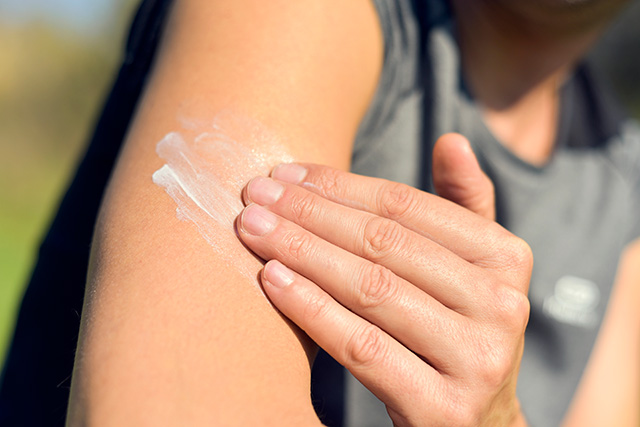
At the end of every dermatology visit, I always try to get in a plug for sunscreen. I want my patients to wear sunscreen every day. Just as they brush their teeth every day, I want them to apply sunscreen every morning before they walk out of the front door. I want it to be a daily habit. I want them to reapply that same sunscreen every two hours if they are enjoying outdoor activities like watching their daughter play soccer or if they are hiking or cycling or walking to the mailbox.
It brings a grin to my face when a patient says, “Oh, well I never go outside so I don’t need sunscreen.” They are about to receive the sunscreen lecture! I might say, “Did you drive here in your car? And did you walk into the clinic from the parking lot, or go to the market for groceries? Or perhaps you have a dog that needs walking?” Inevitably, we all get ultraviolet light every single day, and all of us need sunscreen in order to prevent the harmful rays from causing sun damage which can lead to premature aging and, worse, precancers or skin cancers.
In today’s world, though, there are so many options when it comes to sunscreens. Which one should you choose? It might seem confusing. There are two main categories of sunscreen—chemical and physical. Let’s keep it as simple as possible.
Chemical sunscreens are not what you want. They have long complicated names, they are banned in beautiful states where we like to vacation like Florida and Hawaii (or least in parts of Florida anyway) because the chemicals tend to kill the grass on the golf courses and coral reefs where we like to snorkel and see the colorful fish and friendly (or not so friendly) sea turtles. Chemical sunscreens work by absorbing light and converting it to heat. If someone has dark spots on their skin and they are trying to protect those dark spots from the sunlight, I explain that chemical sunscreen is a definite no-no because the heat reaction will actually worsen the pigmentation. So…chemical sunscreen is not the good one. Most every sunscreen that is easy to find at the Walmart or Target will likely be a chemical one. Spray on sunscreen…chemical. That sunscreen in your makeup or moisturizer you find is quite convenient. It’s a chemical.
When a patient tells me they are allergic to sunscreen, it is virtually always because they have used a chemical sunscreen. If a patient says, they don’t wear sunscreen because it burns and stings when they sweat and it gets in their eyes, it is because they have incorrectly selected a chemical sunscreen. Hopefully the case has been thoroughly made against the use of chemical sunscreens.
Let’s talk about physical block sunscreens, also known as mineral sunblocks. There are really only two of them. They are pretty straightforward. Not really complicated. One is zinc oxide and the other is titanium dioxide. Some people who are quite technical might say iron oxide is one but I am a lumper, not a splitter as my dermatology professor used to say.
Physical block sunscreens work by simply blocking the light from hitting your skin. They reflect the light off of the skin. That is all. No big scientific reaction there. The only problem is finding one that does not make your skin look like one of those lifeguards from the 1950s with a white nose. Imagine that look all over your face….or your entire body. Now imagine that look if you are a darker skin type. It’s not an attractive thought. One should look for an elegant formulation of minerals that is micronized. That is a fancy way of saying that the minerals are so incredibly tiny that you cannot see the white color on your skin even if your skin is very dark. In essence, it is sheer. And yes, everyone needs to wear sunscreen no matter your background skin color because everyone is at risk of the damaging effects of ultraviolet light, including skin cancer.
So hopefully the question of whether to use a chemical versus a physical sunscreen has been answered. I will tackle the Vitamin D issue another day.
Written by Dallas Dermatologist, Ellen Turner, M.D.

